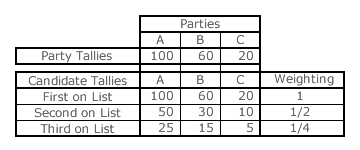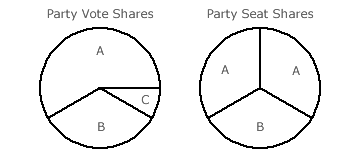Description: Party-List
Party-list elections are held when a broadly representative outcome is required in terms of proportionality between the multiple competing parties. This necessitates having multiple winners where the share of the seats won by each party is in close proportion to its share of the vote. In such elections, each voter simply casts one vote for their preferred party. By counting the total number of votes cast for each party, the set of party tallies is easily determined. The process of deciding how many seats to allocate for a given share of the vote is where the different party-list systems diverge.
Party-list GV/CHPV is applicable to multiple-winner multiple-party elections. Again, the standard GV/CHPV weightings are applied to the list of ranked candidates. Here, however, a list is produced by each party and it is that party and not voters who determine the rank-ordering of its candidates. Such lists are referred to as closed party lists as voters have no control over candidate selection. Voters simply vote for one party and thereby its list of nominated candidates in rank order. Any seats awarded to the party are filled by the candidates uppermost on its own list.

The following three-winner three-party CHPV election example provides a useful illustration; see table opposite. There are 180 voters in total and each one votes solely for the party of their choice. Each of the three parties A, B and C issues a list of its own candidates in strict rank order for all voters to consider. With three seats to be filled, each party nominates three candidates on its list.
In this example, 100, 60 and 20 voters support parties A, B and C respectively. With one vote from each voter, these totals are also the party tallies. To determine which candidates are elected, the candidate tallies must now be calculated.
The CHPV weightings used here are 1, 1/2 and 1/4. Only the first three weightings are needed as there are only three candidates (potential winners) per party list. Therefore, for example, the top-ranked candidate on party list A has a tally of 100 (100 x 1), the second one has a tally of 50 (100 x 1/2) and the remaining candidate has a tally of 25 (100 x 1/4). The tallies for the candidates of party B and C are similarly calculated using the same positional weightings. To fill the three vacant seats, the candidates with the three largest tallies win. The relevant cells are highlighted in white in the above table. Hence, party A wins two seats with tallies of 100 and 50, party B wins one with a tally of 60 and party C wins none.
This method of seat apportionment is known as the 'highest averages' party-list method. CHPV only differs from other such methods in the scaling factors used to calculate the candidate tallies or 'averages' for each party. For CHPV, the candidate tallies are simply the party tally divided by 1, 2, 4, 8 and so on. In other words, candidate tallies are consecutively halved.

Given the votes cast and that only three seats are available, a truly proportional outcome for all parties is not possible. Nevertheless, party B received exactly one third of the vote (60/180) and the same one-third proportion of the three seats; see the pie charts opposite.
Party A received 5/9 (100/180) of the vote and party C got 1/9 (20/180) of it. Each seat is proportionately equivalent to 1/3 or 3/9 of the vote. Hence ideally, party A should have won one seat plus 2/3 of a seat while C should have merely 1/3 of a seat. As fractional seats are not viable, rounding to the nearest integer introduces minimal discrepancy and here it produces the actual election outcome. This result therefore represents the optimum distribution of seats.
Party lists are not always closed ones. An open list allows supporters of a party some influence over the ranking of its candidates. A free list grants full control over the ranking of candidates to party supporters. In order to achieve this ranking, voters for the party need to complete a ranked ballot. The obvious and consistent choice of voting system to determine the overall rank-ordering of the party candidates is ranked ballot CHPV. Therefore, for free party-list elections, party-list CHPV can be used for the awarding of seats to parties while ranked ballot CHPV may be used for the election of candidates to fill those seats. Here, each voter selects their chosen party and then freely rank-orders the candidates on the relevant party list.
Proceed to next section > Description: Summary
Return to previous page > Description: Outcomes
